Assignment: Sustainable Tourism Development
VerifiedAdded on 2021/01/01
|15
|3187
|434
AI Summary
Contribute Materials
Your contribution can guide someone’s learning journey. Share your
documents today.
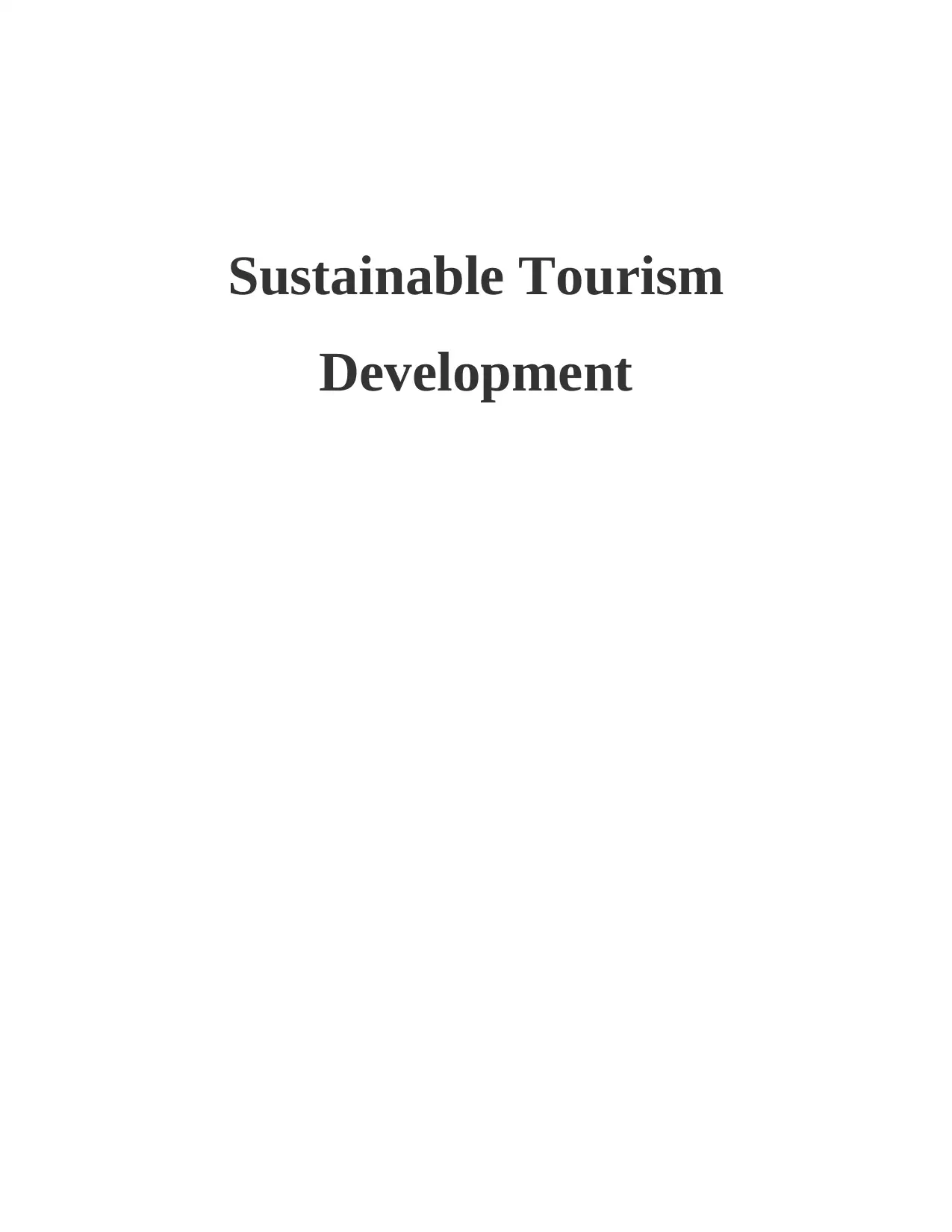
Sustainable Tourism
Development
Development
Secure Best Marks with AI Grader
Need help grading? Try our AI Grader for instant feedback on your assignments.
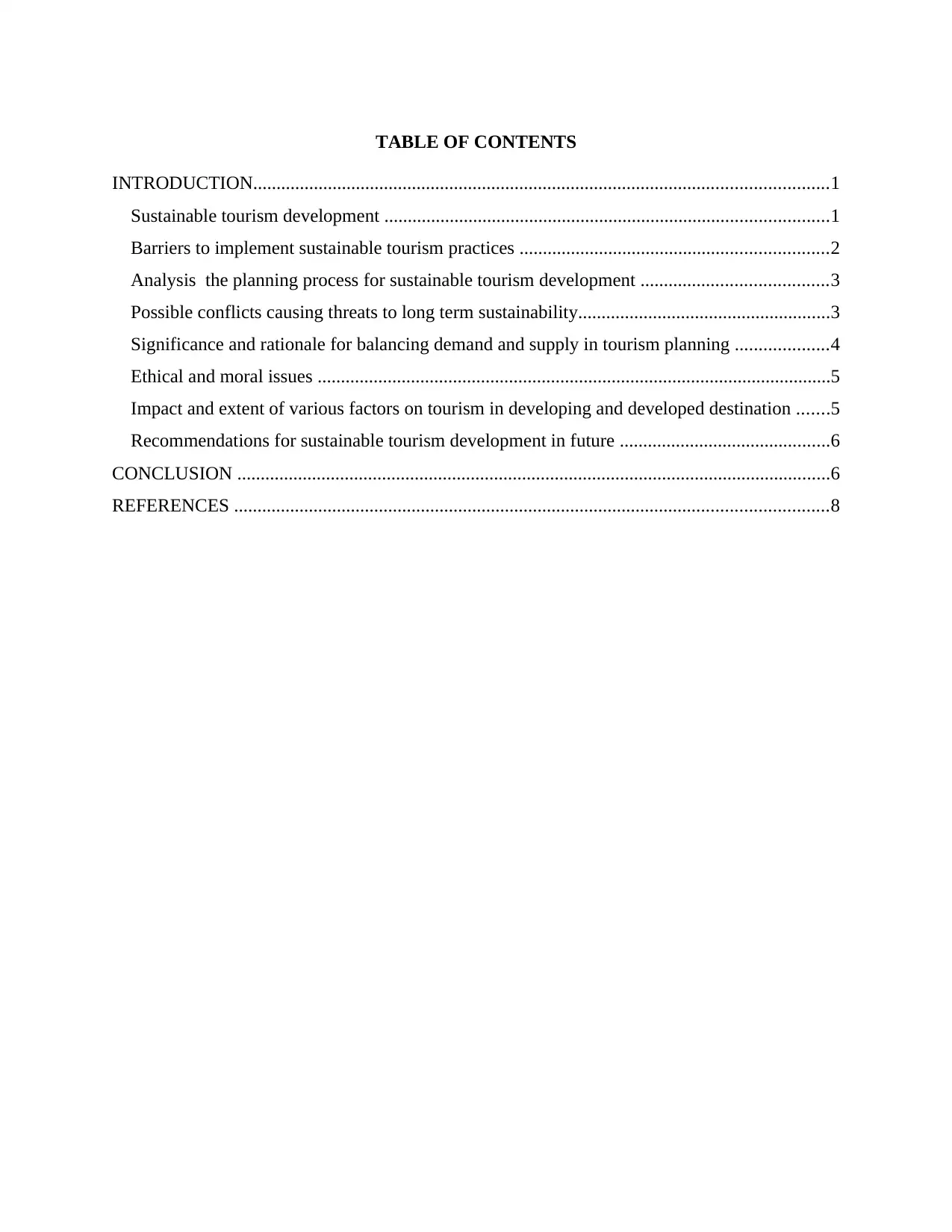
TABLE OF CONTENTS
INTRODUCTION...........................................................................................................................1
Sustainable tourism development ...............................................................................................1
Barriers to implement sustainable tourism practices ..................................................................2
Analysis the planning process for sustainable tourism development ........................................3
Possible conflicts causing threats to long term sustainability......................................................3
Significance and rationale for balancing demand and supply in tourism planning ....................4
Ethical and moral issues ..............................................................................................................5
Impact and extent of various factors on tourism in developing and developed destination .......5
Recommendations for sustainable tourism development in future .............................................6
CONCLUSION ...............................................................................................................................6
REFERENCES ...............................................................................................................................8
INTRODUCTION...........................................................................................................................1
Sustainable tourism development ...............................................................................................1
Barriers to implement sustainable tourism practices ..................................................................2
Analysis the planning process for sustainable tourism development ........................................3
Possible conflicts causing threats to long term sustainability......................................................3
Significance and rationale for balancing demand and supply in tourism planning ....................4
Ethical and moral issues ..............................................................................................................5
Impact and extent of various factors on tourism in developing and developed destination .......5
Recommendations for sustainable tourism development in future .............................................6
CONCLUSION ...............................................................................................................................6
REFERENCES ...............................................................................................................................8
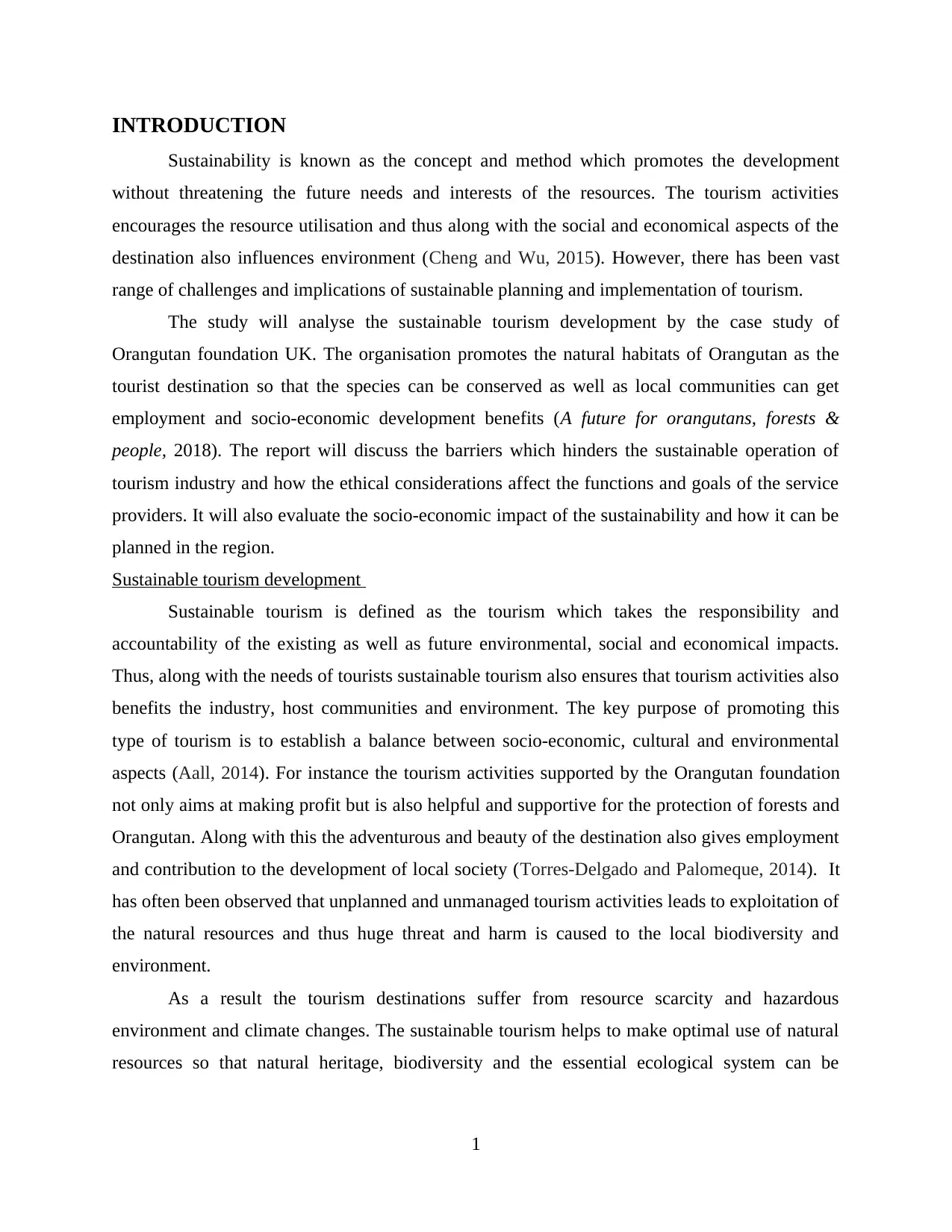
INTRODUCTION
Sustainability is known as the concept and method which promotes the development
without threatening the future needs and interests of the resources. The tourism activities
encourages the resource utilisation and thus along with the social and economical aspects of the
destination also influences environment (Cheng and Wu, 2015). However, there has been vast
range of challenges and implications of sustainable planning and implementation of tourism.
The study will analyse the sustainable tourism development by the case study of
Orangutan foundation UK. The organisation promotes the natural habitats of Orangutan as the
tourist destination so that the species can be conserved as well as local communities can get
employment and socio-economic development benefits (A future for orangutans, forests &
people, 2018). The report will discuss the barriers which hinders the sustainable operation of
tourism industry and how the ethical considerations affect the functions and goals of the service
providers. It will also evaluate the socio-economic impact of the sustainability and how it can be
planned in the region.
Sustainable tourism development
Sustainable tourism is defined as the tourism which takes the responsibility and
accountability of the existing as well as future environmental, social and economical impacts.
Thus, along with the needs of tourists sustainable tourism also ensures that tourism activities also
benefits the industry, host communities and environment. The key purpose of promoting this
type of tourism is to establish a balance between socio-economic, cultural and environmental
aspects (Aall, 2014). For instance the tourism activities supported by the Orangutan foundation
not only aims at making profit but is also helpful and supportive for the protection of forests and
Orangutan. Along with this the adventurous and beauty of the destination also gives employment
and contribution to the development of local society (Torres-Delgado and Palomeque, 2014). It
has often been observed that unplanned and unmanaged tourism activities leads to exploitation of
the natural resources and thus huge threat and harm is caused to the local biodiversity and
environment.
As a result the tourism destinations suffer from resource scarcity and hazardous
environment and climate changes. The sustainable tourism helps to make optimal use of natural
resources so that natural heritage, biodiversity and the essential ecological system can be
1
Sustainability is known as the concept and method which promotes the development
without threatening the future needs and interests of the resources. The tourism activities
encourages the resource utilisation and thus along with the social and economical aspects of the
destination also influences environment (Cheng and Wu, 2015). However, there has been vast
range of challenges and implications of sustainable planning and implementation of tourism.
The study will analyse the sustainable tourism development by the case study of
Orangutan foundation UK. The organisation promotes the natural habitats of Orangutan as the
tourist destination so that the species can be conserved as well as local communities can get
employment and socio-economic development benefits (A future for orangutans, forests &
people, 2018). The report will discuss the barriers which hinders the sustainable operation of
tourism industry and how the ethical considerations affect the functions and goals of the service
providers. It will also evaluate the socio-economic impact of the sustainability and how it can be
planned in the region.
Sustainable tourism development
Sustainable tourism is defined as the tourism which takes the responsibility and
accountability of the existing as well as future environmental, social and economical impacts.
Thus, along with the needs of tourists sustainable tourism also ensures that tourism activities also
benefits the industry, host communities and environment. The key purpose of promoting this
type of tourism is to establish a balance between socio-economic, cultural and environmental
aspects (Aall, 2014). For instance the tourism activities supported by the Orangutan foundation
not only aims at making profit but is also helpful and supportive for the protection of forests and
Orangutan. Along with this the adventurous and beauty of the destination also gives employment
and contribution to the development of local society (Torres-Delgado and Palomeque, 2014). It
has often been observed that unplanned and unmanaged tourism activities leads to exploitation of
the natural resources and thus huge threat and harm is caused to the local biodiversity and
environment.
As a result the tourism destinations suffer from resource scarcity and hazardous
environment and climate changes. The sustainable tourism helps to make optimal use of natural
resources so that natural heritage, biodiversity and the essential ecological system can be
1

preserved. The true essence of the tourism is to witness the cultural and traditional heritage of the
destination. However, these elements are often neglected and harmed for encouraging tourism.
Thus, it is required that service providers must promote the sustainability concept so that
the cultural and social authenticity of the local and host communities can be protected. Another
significant advantage of sustainable tourism is that it ensures that the economic benefits are
uniformly and fairly distributed among all the stakeholders. The well planned sustainable
tourism focuses on providing quality and satisfactory services to the visitors by integrating all the
three pillars of the sustainability (Jamal and Camargo, 2014). For the travel and tourism service
providers it is necessary to promote sustainability so that the tourism is accepted encouraged by
the local communities as well and they can offer the best services to visitors.
Barriers to implement sustainable tourism practices
Despite having necessity and several advantages it is not easy for Orangutan foundation
to implement and plan sustainable tourism projects. One of the key barrier is that most of the
travellers as well as service providers assume sustainability as synonyms with environment
conservation. The socio-economic perspective is often neglected in the planning. As a result the
organisation and the service users are remains unknown with the methods to make tourism
sustainable. The level of decision making and control management at Orangutan foundation is
also one of the barrier. Due to lack of proper strategic planning and awareness service providers
pay less attention to the sustainability (Ruhanen and et.al., 2015). Economic barriers are also
critical factors which creates difficulty in planning sustainable tourism. The higher governance
authorities gives preference to financial benefits instead of social or environment safety.
From the perspective of profitability and business neither the local authorities nor the
service providers desire to compromise in the operational processes for the welfare of local
communities. This barrier becomes more dominant in developing countries where multinational
hotel and tourism organisation forces local government to encourage tourism at any cost without
having concern for the natural resources or the cultural elements of the society. The social factors
can also acts as barrier to encourage sustainable practices. For instance when local communities
does not have interest and authority to participate in the decision making then it is not possible to
integrate the social sustainability into the practice.
Due to lack of awareness also many people assumes that how visiting or tourist will
cause harm to nature or the resource exploitation (Whitelaw, King and Tolkach, 2014). Thus, this
2
destination. However, these elements are often neglected and harmed for encouraging tourism.
Thus, it is required that service providers must promote the sustainability concept so that
the cultural and social authenticity of the local and host communities can be protected. Another
significant advantage of sustainable tourism is that it ensures that the economic benefits are
uniformly and fairly distributed among all the stakeholders. The well planned sustainable
tourism focuses on providing quality and satisfactory services to the visitors by integrating all the
three pillars of the sustainability (Jamal and Camargo, 2014). For the travel and tourism service
providers it is necessary to promote sustainability so that the tourism is accepted encouraged by
the local communities as well and they can offer the best services to visitors.
Barriers to implement sustainable tourism practices
Despite having necessity and several advantages it is not easy for Orangutan foundation
to implement and plan sustainable tourism projects. One of the key barrier is that most of the
travellers as well as service providers assume sustainability as synonyms with environment
conservation. The socio-economic perspective is often neglected in the planning. As a result the
organisation and the service users are remains unknown with the methods to make tourism
sustainable. The level of decision making and control management at Orangutan foundation is
also one of the barrier. Due to lack of proper strategic planning and awareness service providers
pay less attention to the sustainability (Ruhanen and et.al., 2015). Economic barriers are also
critical factors which creates difficulty in planning sustainable tourism. The higher governance
authorities gives preference to financial benefits instead of social or environment safety.
From the perspective of profitability and business neither the local authorities nor the
service providers desire to compromise in the operational processes for the welfare of local
communities. This barrier becomes more dominant in developing countries where multinational
hotel and tourism organisation forces local government to encourage tourism at any cost without
having concern for the natural resources or the cultural elements of the society. The social factors
can also acts as barrier to encourage sustainable practices. For instance when local communities
does not have interest and authority to participate in the decision making then it is not possible to
integrate the social sustainability into the practice.
Due to lack of awareness also many people assumes that how visiting or tourist will
cause harm to nature or the resource exploitation (Whitelaw, King and Tolkach, 2014). Thus, this
2
Secure Best Marks with AI Grader
Need help grading? Try our AI Grader for instant feedback on your assignments.
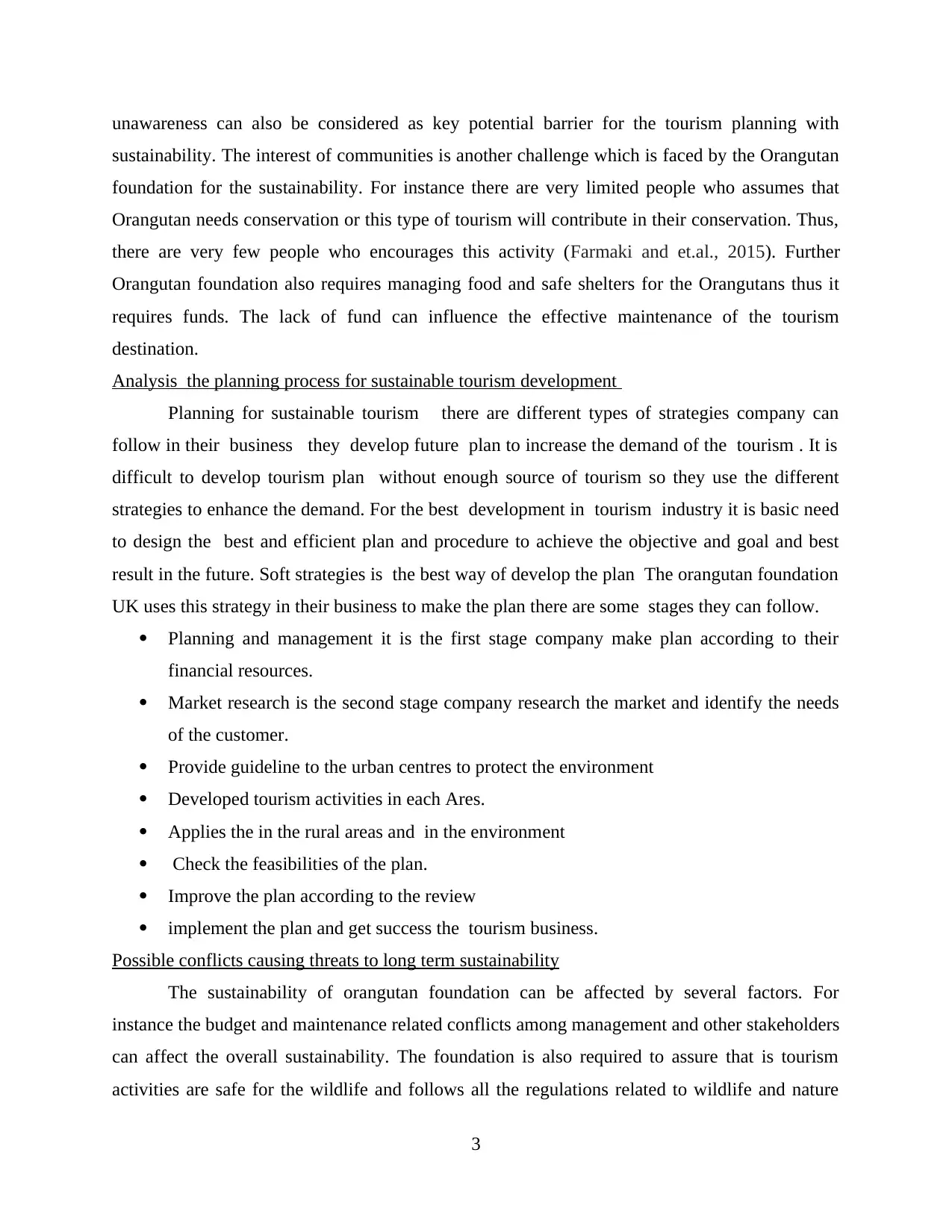
unawareness can also be considered as key potential barrier for the tourism planning with
sustainability. The interest of communities is another challenge which is faced by the Orangutan
foundation for the sustainability. For instance there are very limited people who assumes that
Orangutan needs conservation or this type of tourism will contribute in their conservation. Thus,
there are very few people who encourages this activity (Farmaki and et.al., 2015). Further
Orangutan foundation also requires managing food and safe shelters for the Orangutans thus it
requires funds. The lack of fund can influence the effective maintenance of the tourism
destination.
Analysis the planning process for sustainable tourism development
Planning for sustainable tourism there are different types of strategies company can
follow in their business they develop future plan to increase the demand of the tourism . It is
difficult to develop tourism plan without enough source of tourism so they use the different
strategies to enhance the demand. For the best development in tourism industry it is basic need
to design the best and efficient plan and procedure to achieve the objective and goal and best
result in the future. Soft strategies is the best way of develop the plan The orangutan foundation
UK uses this strategy in their business to make the plan there are some stages they can follow.
Planning and management it is the first stage company make plan according to their
financial resources.
Market research is the second stage company research the market and identify the needs
of the customer.
Provide guideline to the urban centres to protect the environment
Developed tourism activities in each Ares.
Applies the in the rural areas and in the environment
Check the feasibilities of the plan.
Improve the plan according to the review
implement the plan and get success the tourism business.
Possible conflicts causing threats to long term sustainability
The sustainability of orangutan foundation can be affected by several factors. For
instance the budget and maintenance related conflicts among management and other stakeholders
can affect the overall sustainability. The foundation is also required to assure that is tourism
activities are safe for the wildlife and follows all the regulations related to wildlife and nature
3
sustainability. The interest of communities is another challenge which is faced by the Orangutan
foundation for the sustainability. For instance there are very limited people who assumes that
Orangutan needs conservation or this type of tourism will contribute in their conservation. Thus,
there are very few people who encourages this activity (Farmaki and et.al., 2015). Further
Orangutan foundation also requires managing food and safe shelters for the Orangutans thus it
requires funds. The lack of fund can influence the effective maintenance of the tourism
destination.
Analysis the planning process for sustainable tourism development
Planning for sustainable tourism there are different types of strategies company can
follow in their business they develop future plan to increase the demand of the tourism . It is
difficult to develop tourism plan without enough source of tourism so they use the different
strategies to enhance the demand. For the best development in tourism industry it is basic need
to design the best and efficient plan and procedure to achieve the objective and goal and best
result in the future. Soft strategies is the best way of develop the plan The orangutan foundation
UK uses this strategy in their business to make the plan there are some stages they can follow.
Planning and management it is the first stage company make plan according to their
financial resources.
Market research is the second stage company research the market and identify the needs
of the customer.
Provide guideline to the urban centres to protect the environment
Developed tourism activities in each Ares.
Applies the in the rural areas and in the environment
Check the feasibilities of the plan.
Improve the plan according to the review
implement the plan and get success the tourism business.
Possible conflicts causing threats to long term sustainability
The sustainability of orangutan foundation can be affected by several factors. For
instance the budget and maintenance related conflicts among management and other stakeholders
can affect the overall sustainability. The foundation is also required to assure that is tourism
activities are safe for the wildlife and follows all the regulations related to wildlife and nature
3
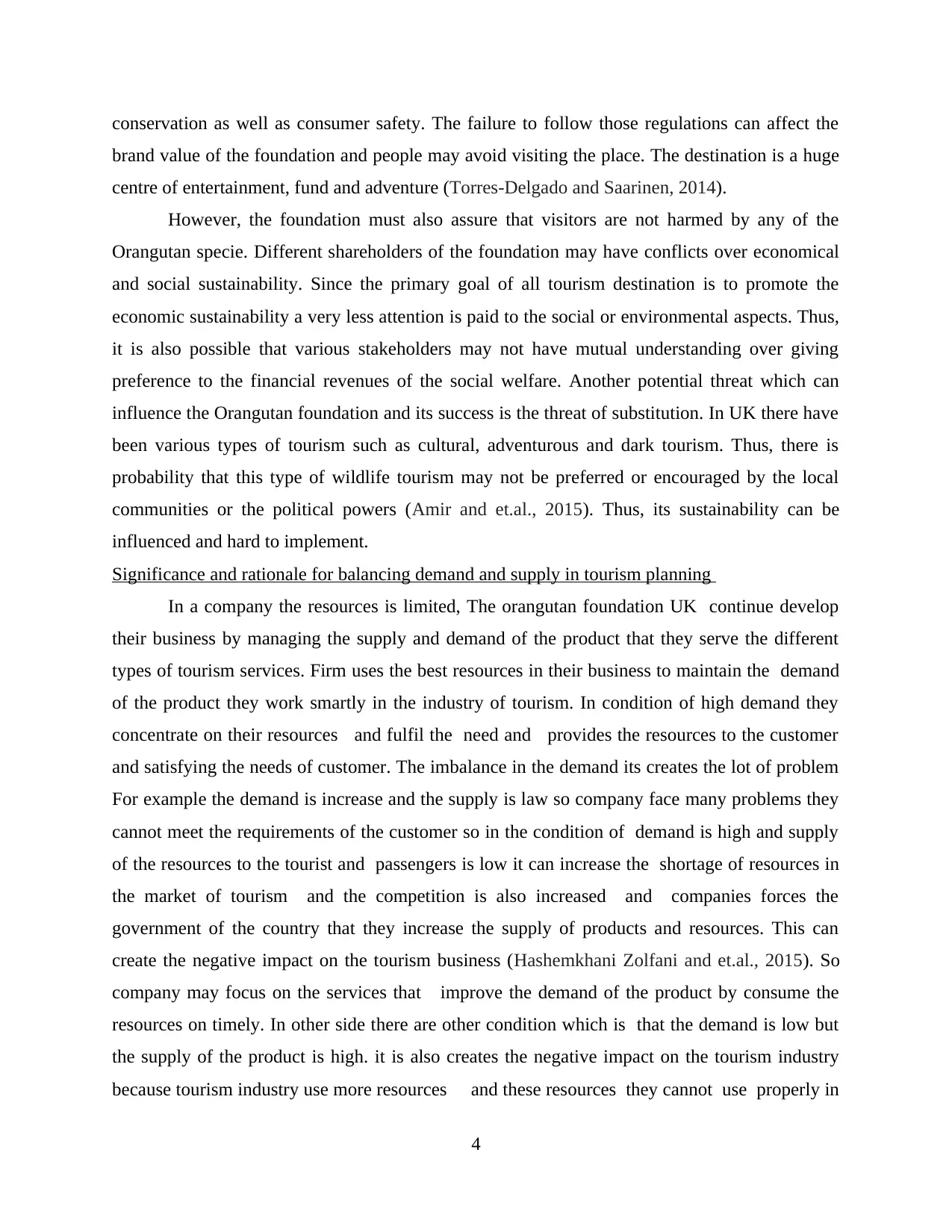
conservation as well as consumer safety. The failure to follow those regulations can affect the
brand value of the foundation and people may avoid visiting the place. The destination is a huge
centre of entertainment, fund and adventure (Torres-Delgado and Saarinen, 2014).
However, the foundation must also assure that visitors are not harmed by any of the
Orangutan specie. Different shareholders of the foundation may have conflicts over economical
and social sustainability. Since the primary goal of all tourism destination is to promote the
economic sustainability a very less attention is paid to the social or environmental aspects. Thus,
it is also possible that various stakeholders may not have mutual understanding over giving
preference to the financial revenues of the social welfare. Another potential threat which can
influence the Orangutan foundation and its success is the threat of substitution. In UK there have
been various types of tourism such as cultural, adventurous and dark tourism. Thus, there is
probability that this type of wildlife tourism may not be preferred or encouraged by the local
communities or the political powers (Amir and et.al., 2015). Thus, its sustainability can be
influenced and hard to implement.
Significance and rationale for balancing demand and supply in tourism planning
In a company the resources is limited, The orangutan foundation UK continue develop
their business by managing the supply and demand of the product that they serve the different
types of tourism services. Firm uses the best resources in their business to maintain the demand
of the product they work smartly in the industry of tourism. In condition of high demand they
concentrate on their resources and fulfil the need and provides the resources to the customer
and satisfying the needs of customer. The imbalance in the demand its creates the lot of problem
For example the demand is increase and the supply is law so company face many problems they
cannot meet the requirements of the customer so in the condition of demand is high and supply
of the resources to the tourist and passengers is low it can increase the shortage of resources in
the market of tourism and the competition is also increased and companies forces the
government of the country that they increase the supply of products and resources. This can
create the negative impact on the tourism business (Hashemkhani Zolfani and et.al., 2015). So
company may focus on the services that improve the demand of the product by consume the
resources on timely. In other side there are other condition which is that the demand is low but
the supply of the product is high. it is also creates the negative impact on the tourism industry
because tourism industry use more resources and these resources they cannot use properly in
4
brand value of the foundation and people may avoid visiting the place. The destination is a huge
centre of entertainment, fund and adventure (Torres-Delgado and Saarinen, 2014).
However, the foundation must also assure that visitors are not harmed by any of the
Orangutan specie. Different shareholders of the foundation may have conflicts over economical
and social sustainability. Since the primary goal of all tourism destination is to promote the
economic sustainability a very less attention is paid to the social or environmental aspects. Thus,
it is also possible that various stakeholders may not have mutual understanding over giving
preference to the financial revenues of the social welfare. Another potential threat which can
influence the Orangutan foundation and its success is the threat of substitution. In UK there have
been various types of tourism such as cultural, adventurous and dark tourism. Thus, there is
probability that this type of wildlife tourism may not be preferred or encouraged by the local
communities or the political powers (Amir and et.al., 2015). Thus, its sustainability can be
influenced and hard to implement.
Significance and rationale for balancing demand and supply in tourism planning
In a company the resources is limited, The orangutan foundation UK continue develop
their business by managing the supply and demand of the product that they serve the different
types of tourism services. Firm uses the best resources in their business to maintain the demand
of the product they work smartly in the industry of tourism. In condition of high demand they
concentrate on their resources and fulfil the need and provides the resources to the customer
and satisfying the needs of customer. The imbalance in the demand its creates the lot of problem
For example the demand is increase and the supply is law so company face many problems they
cannot meet the requirements of the customer so in the condition of demand is high and supply
of the resources to the tourist and passengers is low it can increase the shortage of resources in
the market of tourism and the competition is also increased and companies forces the
government of the country that they increase the supply of products and resources. This can
create the negative impact on the tourism business (Hashemkhani Zolfani and et.al., 2015). So
company may focus on the services that improve the demand of the product by consume the
resources on timely. In other side there are other condition which is that the demand is low but
the supply of the product is high. it is also creates the negative impact on the tourism industry
because tourism industry use more resources and these resources they cannot use properly in
4

their business. Also, company will consume the resource early before the specified time. This
make the balance between supply and demand.
Ethical and moral issues
There have been several ethical and moral principles associated with the tourism
development. For instance the planners and developers of Orangutan foundation has primary
concern that the interference of people must not disturb the local citizens as well as Orangutan.
The overcrowding can be hard to manage for the organisers as it can disturb the peaceful habitat
of the Orangutan and local communities. Contrary to the host communities are concerned that if
number of tourists will be greater than they will get more opportunities and options to promote
UK as the famous destination for the wildlife and nature conservation.
For sustaining the natural resources and essence of the tourism destination visitors are
also expected to follow certain ethical and moral principles (Jovicic, 2014). For instance for
making the travelling experience exciting and thrilling the foundation also allows visitors to play
with the species within forest. However, ethically it can cause disturbance to the privacy of the
Orangutan and other forest species. Thus, it is the moral duty of the service provider to ensure
that he activities of the tourist does not cause any harm to the safety of forest resources and
species. The service providers must also ensure that for the economic sustainability all necessary
services such as food court and comforting facilities are provided to consumers so that desired
revenues can be generated (Carr, Ruhanen and Whitford, 2016). The equal participation of the
local communities in the prevention and protection of the wildlife also encourages the comfort
and safety of tourist as well as social sustainability.
Impact and extent of various factors on tourism in developing and developed destination
Several factors have different impact on the tourism destinations and their sustainability.
These impacts have huge variation in developing destinations such as Bhutan or developed
destinations like UK. For instance in UK it has been observed that most of the existing
destinations are focused on economic development and aims to reflect the social and cultural
value of the local communities. Contrary to this in Bhutan still there is need of huge
development from the economic perspective. The destination is very rich in natural resources and
local communities are very protective in term of environment sustainability (Budeanu and et.al.,
2016). In order to develop it as tourism destination on wider level involvement of local
communities and government authorities need to be increased.
5
make the balance between supply and demand.
Ethical and moral issues
There have been several ethical and moral principles associated with the tourism
development. For instance the planners and developers of Orangutan foundation has primary
concern that the interference of people must not disturb the local citizens as well as Orangutan.
The overcrowding can be hard to manage for the organisers as it can disturb the peaceful habitat
of the Orangutan and local communities. Contrary to the host communities are concerned that if
number of tourists will be greater than they will get more opportunities and options to promote
UK as the famous destination for the wildlife and nature conservation.
For sustaining the natural resources and essence of the tourism destination visitors are
also expected to follow certain ethical and moral principles (Jovicic, 2014). For instance for
making the travelling experience exciting and thrilling the foundation also allows visitors to play
with the species within forest. However, ethically it can cause disturbance to the privacy of the
Orangutan and other forest species. Thus, it is the moral duty of the service provider to ensure
that he activities of the tourist does not cause any harm to the safety of forest resources and
species. The service providers must also ensure that for the economic sustainability all necessary
services such as food court and comforting facilities are provided to consumers so that desired
revenues can be generated (Carr, Ruhanen and Whitford, 2016). The equal participation of the
local communities in the prevention and protection of the wildlife also encourages the comfort
and safety of tourist as well as social sustainability.
Impact and extent of various factors on tourism in developing and developed destination
Several factors have different impact on the tourism destinations and their sustainability.
These impacts have huge variation in developing destinations such as Bhutan or developed
destinations like UK. For instance in UK it has been observed that most of the existing
destinations are focused on economic development and aims to reflect the social and cultural
value of the local communities. Contrary to this in Bhutan still there is need of huge
development from the economic perspective. The destination is very rich in natural resources and
local communities are very protective in term of environment sustainability (Budeanu and et.al.,
2016). In order to develop it as tourism destination on wider level involvement of local
communities and government authorities need to be increased.
5
Paraphrase This Document
Need a fresh take? Get an instant paraphrase of this document with our AI Paraphraser
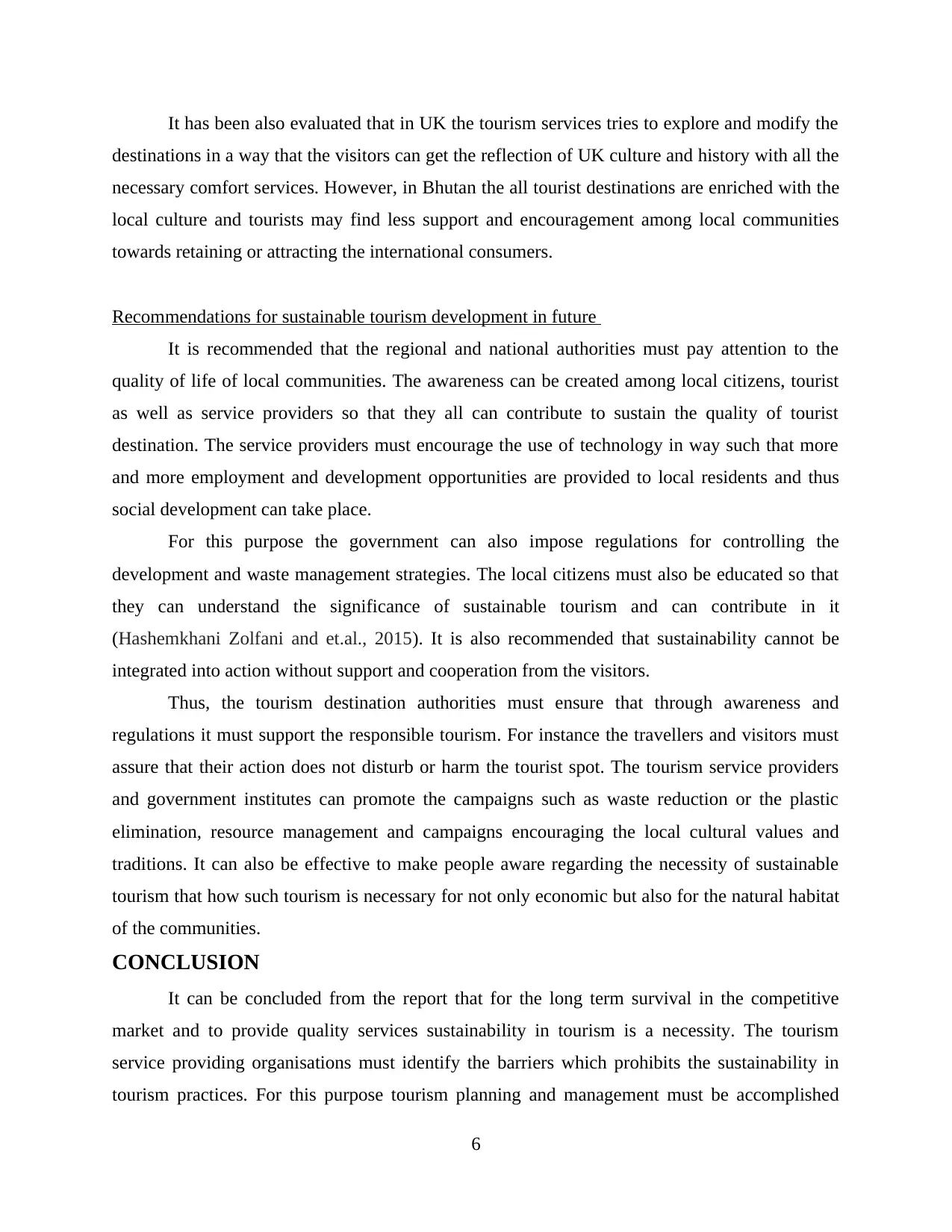
It has been also evaluated that in UK the tourism services tries to explore and modify the
destinations in a way that the visitors can get the reflection of UK culture and history with all the
necessary comfort services. However, in Bhutan the all tourist destinations are enriched with the
local culture and tourists may find less support and encouragement among local communities
towards retaining or attracting the international consumers.
Recommendations for sustainable tourism development in future
It is recommended that the regional and national authorities must pay attention to the
quality of life of local communities. The awareness can be created among local citizens, tourist
as well as service providers so that they all can contribute to sustain the quality of tourist
destination. The service providers must encourage the use of technology in way such that more
and more employment and development opportunities are provided to local residents and thus
social development can take place.
For this purpose the government can also impose regulations for controlling the
development and waste management strategies. The local citizens must also be educated so that
they can understand the significance of sustainable tourism and can contribute in it
(Hashemkhani Zolfani and et.al., 2015). It is also recommended that sustainability cannot be
integrated into action without support and cooperation from the visitors.
Thus, the tourism destination authorities must ensure that through awareness and
regulations it must support the responsible tourism. For instance the travellers and visitors must
assure that their action does not disturb or harm the tourist spot. The tourism service providers
and government institutes can promote the campaigns such as waste reduction or the plastic
elimination, resource management and campaigns encouraging the local cultural values and
traditions. It can also be effective to make people aware regarding the necessity of sustainable
tourism that how such tourism is necessary for not only economic but also for the natural habitat
of the communities.
CONCLUSION
It can be concluded from the report that for the long term survival in the competitive
market and to provide quality services sustainability in tourism is a necessity. The tourism
service providing organisations must identify the barriers which prohibits the sustainability in
tourism practices. For this purpose tourism planning and management must be accomplished
6
destinations in a way that the visitors can get the reflection of UK culture and history with all the
necessary comfort services. However, in Bhutan the all tourist destinations are enriched with the
local culture and tourists may find less support and encouragement among local communities
towards retaining or attracting the international consumers.
Recommendations for sustainable tourism development in future
It is recommended that the regional and national authorities must pay attention to the
quality of life of local communities. The awareness can be created among local citizens, tourist
as well as service providers so that they all can contribute to sustain the quality of tourist
destination. The service providers must encourage the use of technology in way such that more
and more employment and development opportunities are provided to local residents and thus
social development can take place.
For this purpose the government can also impose regulations for controlling the
development and waste management strategies. The local citizens must also be educated so that
they can understand the significance of sustainable tourism and can contribute in it
(Hashemkhani Zolfani and et.al., 2015). It is also recommended that sustainability cannot be
integrated into action without support and cooperation from the visitors.
Thus, the tourism destination authorities must ensure that through awareness and
regulations it must support the responsible tourism. For instance the travellers and visitors must
assure that their action does not disturb or harm the tourist spot. The tourism service providers
and government institutes can promote the campaigns such as waste reduction or the plastic
elimination, resource management and campaigns encouraging the local cultural values and
traditions. It can also be effective to make people aware regarding the necessity of sustainable
tourism that how such tourism is necessary for not only economic but also for the natural habitat
of the communities.
CONCLUSION
It can be concluded from the report that for the long term survival in the competitive
market and to provide quality services sustainability in tourism is a necessity. The tourism
service providing organisations must identify the barriers which prohibits the sustainability in
tourism practices. For this purpose tourism planning and management must be accomplished
6
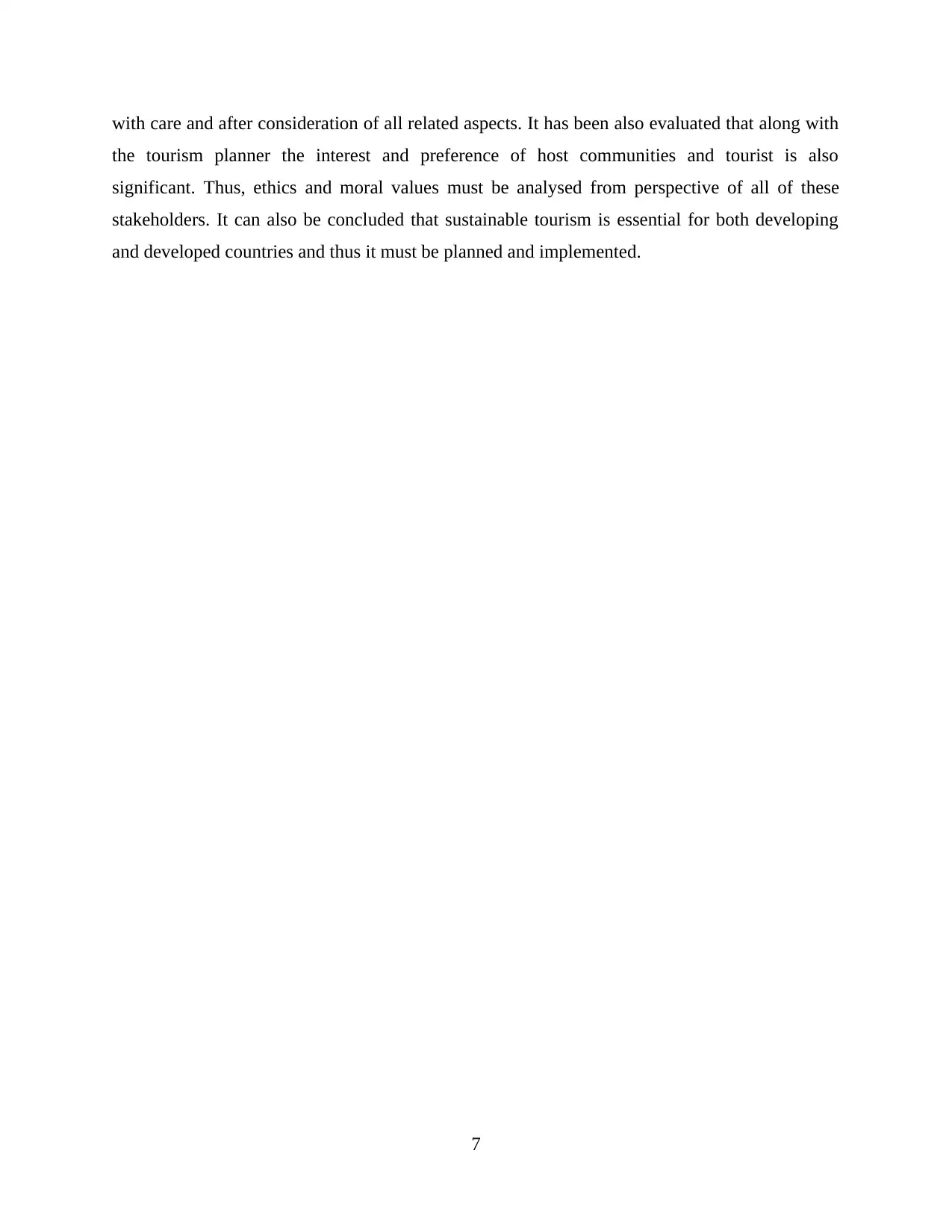
with care and after consideration of all related aspects. It has been also evaluated that along with
the tourism planner the interest and preference of host communities and tourist is also
significant. Thus, ethics and moral values must be analysed from perspective of all of these
stakeholders. It can also be concluded that sustainable tourism is essential for both developing
and developed countries and thus it must be planned and implemented.
7
the tourism planner the interest and preference of host communities and tourist is also
significant. Thus, ethics and moral values must be analysed from perspective of all of these
stakeholders. It can also be concluded that sustainable tourism is essential for both developing
and developed countries and thus it must be planned and implemented.
7
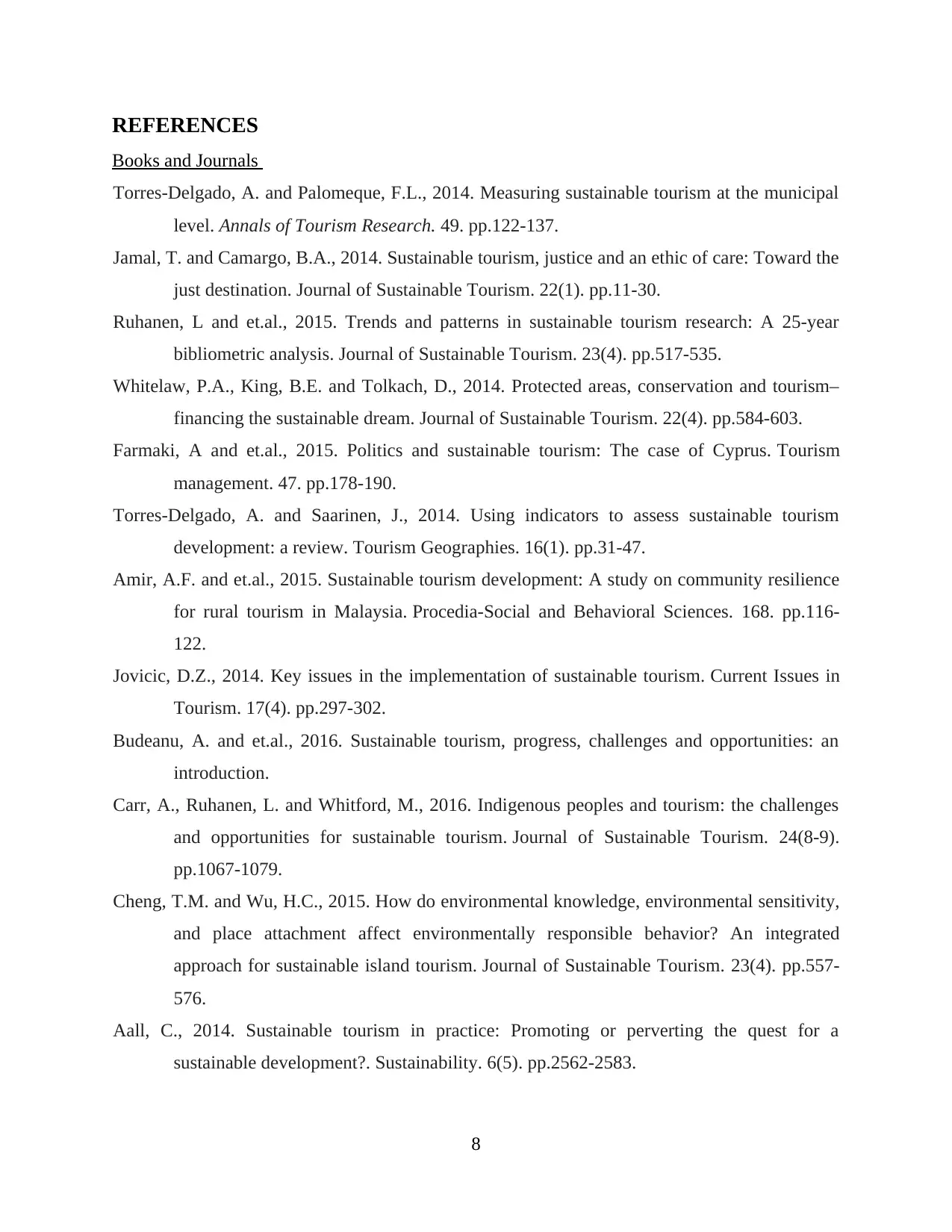
REFERENCES
Books and Journals
Torres-Delgado, A. and Palomeque, F.L., 2014. Measuring sustainable tourism at the municipal
level. Annals of Tourism Research. 49. pp.122-137.
Jamal, T. and Camargo, B.A., 2014. Sustainable tourism, justice and an ethic of care: Toward the
just destination. Journal of Sustainable Tourism. 22(1). pp.11-30.
Ruhanen, L and et.al., 2015. Trends and patterns in sustainable tourism research: A 25-year
bibliometric analysis. Journal of Sustainable Tourism. 23(4). pp.517-535.
Whitelaw, P.A., King, B.E. and Tolkach, D., 2014. Protected areas, conservation and tourism–
financing the sustainable dream. Journal of Sustainable Tourism. 22(4). pp.584-603.
Farmaki, A and et.al., 2015. Politics and sustainable tourism: The case of Cyprus. Tourism
management. 47. pp.178-190.
Torres-Delgado, A. and Saarinen, J., 2014. Using indicators to assess sustainable tourism
development: a review. Tourism Geographies. 16(1). pp.31-47.
Amir, A.F. and et.al., 2015. Sustainable tourism development: A study on community resilience
for rural tourism in Malaysia. Procedia-Social and Behavioral Sciences. 168. pp.116-
122.
Jovicic, D.Z., 2014. Key issues in the implementation of sustainable tourism. Current Issues in
Tourism. 17(4). pp.297-302.
Budeanu, A. and et.al., 2016. Sustainable tourism, progress, challenges and opportunities: an
introduction.
Carr, A., Ruhanen, L. and Whitford, M., 2016. Indigenous peoples and tourism: the challenges
and opportunities for sustainable tourism. Journal of Sustainable Tourism. 24(8-9).
pp.1067-1079.
Cheng, T.M. and Wu, H.C., 2015. How do environmental knowledge, environmental sensitivity,
and place attachment affect environmentally responsible behavior? An integrated
approach for sustainable island tourism. Journal of Sustainable Tourism. 23(4). pp.557-
576.
Aall, C., 2014. Sustainable tourism in practice: Promoting or perverting the quest for a
sustainable development?. Sustainability. 6(5). pp.2562-2583.
8
Books and Journals
Torres-Delgado, A. and Palomeque, F.L., 2014. Measuring sustainable tourism at the municipal
level. Annals of Tourism Research. 49. pp.122-137.
Jamal, T. and Camargo, B.A., 2014. Sustainable tourism, justice and an ethic of care: Toward the
just destination. Journal of Sustainable Tourism. 22(1). pp.11-30.
Ruhanen, L and et.al., 2015. Trends and patterns in sustainable tourism research: A 25-year
bibliometric analysis. Journal of Sustainable Tourism. 23(4). pp.517-535.
Whitelaw, P.A., King, B.E. and Tolkach, D., 2014. Protected areas, conservation and tourism–
financing the sustainable dream. Journal of Sustainable Tourism. 22(4). pp.584-603.
Farmaki, A and et.al., 2015. Politics and sustainable tourism: The case of Cyprus. Tourism
management. 47. pp.178-190.
Torres-Delgado, A. and Saarinen, J., 2014. Using indicators to assess sustainable tourism
development: a review. Tourism Geographies. 16(1). pp.31-47.
Amir, A.F. and et.al., 2015. Sustainable tourism development: A study on community resilience
for rural tourism in Malaysia. Procedia-Social and Behavioral Sciences. 168. pp.116-
122.
Jovicic, D.Z., 2014. Key issues in the implementation of sustainable tourism. Current Issues in
Tourism. 17(4). pp.297-302.
Budeanu, A. and et.al., 2016. Sustainable tourism, progress, challenges and opportunities: an
introduction.
Carr, A., Ruhanen, L. and Whitford, M., 2016. Indigenous peoples and tourism: the challenges
and opportunities for sustainable tourism. Journal of Sustainable Tourism. 24(8-9).
pp.1067-1079.
Cheng, T.M. and Wu, H.C., 2015. How do environmental knowledge, environmental sensitivity,
and place attachment affect environmentally responsible behavior? An integrated
approach for sustainable island tourism. Journal of Sustainable Tourism. 23(4). pp.557-
576.
Aall, C., 2014. Sustainable tourism in practice: Promoting or perverting the quest for a
sustainable development?. Sustainability. 6(5). pp.2562-2583.
8
Secure Best Marks with AI Grader
Need help grading? Try our AI Grader for instant feedback on your assignments.
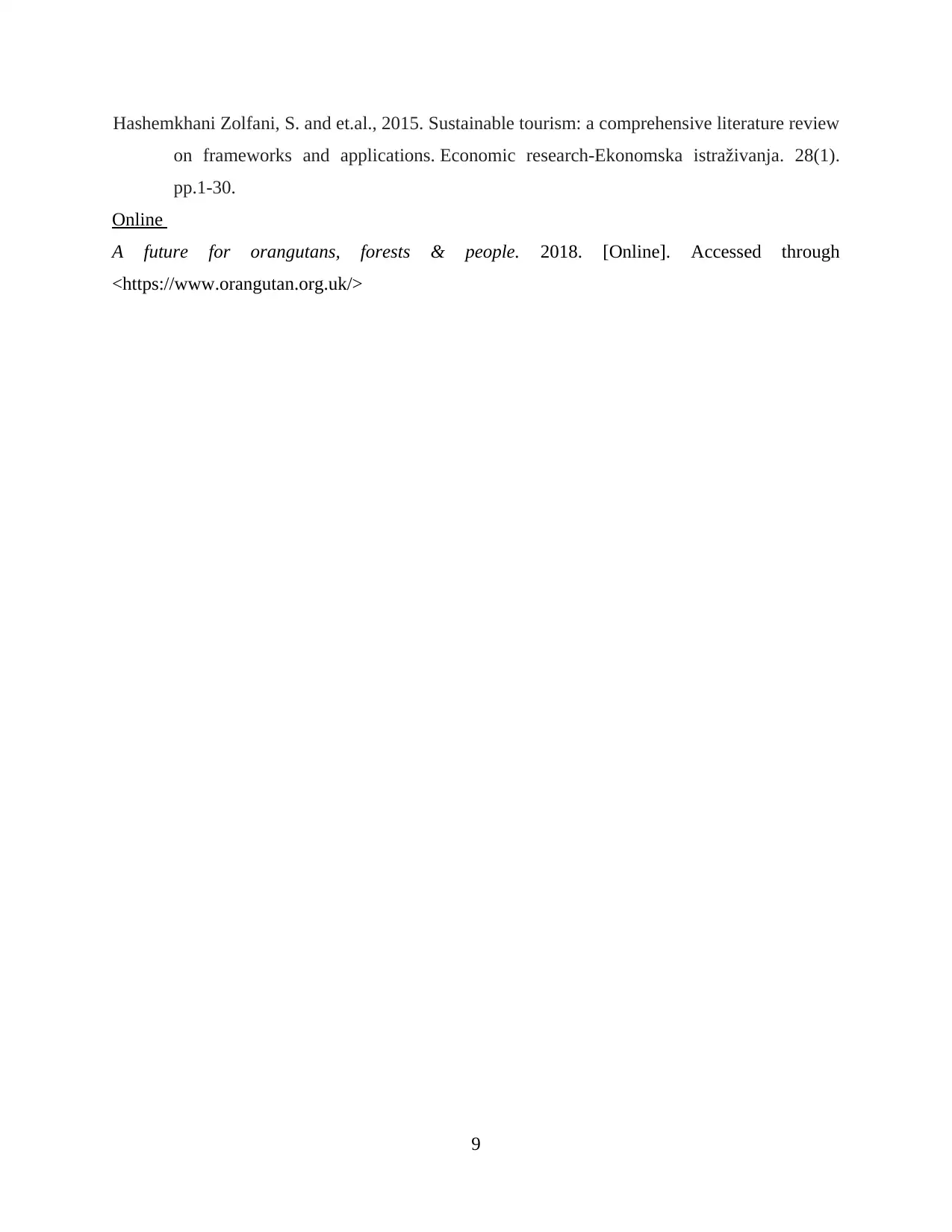
Hashemkhani Zolfani, S. and et.al., 2015. Sustainable tourism: a comprehensive literature review
on frameworks and applications. Economic research-Ekonomska istraživanja. 28(1).
pp.1-30.
Online
A future for orangutans, forests & people. 2018. [Online]. Accessed through
<https://www.orangutan.org.uk/>
9
on frameworks and applications. Economic research-Ekonomska istraživanja. 28(1).
pp.1-30.
Online
A future for orangutans, forests & people. 2018. [Online]. Accessed through
<https://www.orangutan.org.uk/>
9

10

11
Paraphrase This Document
Need a fresh take? Get an instant paraphrase of this document with our AI Paraphraser

12

13
1 out of 15
Your All-in-One AI-Powered Toolkit for Academic Success.
+13062052269
info@desklib.com
Available 24*7 on WhatsApp / Email
![[object Object]](/_next/static/media/star-bottom.7253800d.svg)
Unlock your academic potential
© 2024 | Zucol Services PVT LTD | All rights reserved.


